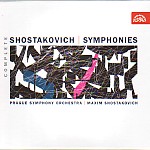Stravinsky said that he thought it was important to record his own music so that future generations will know how it should be played, even if others might conduct it better from a technical point of view, or have better orchestras at their disposal. This thought comes to mind listening to this set, but it wasn’t something to be taken for granted. Obviously, Maxim Shostakovich is not the composer, however close he may have been to him. Beyond that, although he recorded excellent versions of the Fifth and Fifteenth Symphonies for Melodiya (only the former generally available on CD), he also made some really boring, rhythmically flaccid, indifferently played versions of the Seventh and Eighth Symphonies for Collins Classics.
Soon after that, however, Maxim began this series in Prague, much more promisingly. Some of these performances, at least Symphonies Nos. 4, 5, 6, and 13, were released previously, and they are all excellent (even with that extra bar in the coda of the Fifth, a curiosity that seems to pop up now and then). These are all live recordings, and the sense of occasion is palpable, even when there are moments of iffy ensemble (the end of the Eleventh, the big climax in the finale of the Eighth). In all honesty, the Prague Symphony is not in the league of the Czech Philharmonic–or the various orchestras that Jansons has in his complete set, or (obviously) Haitink’s Concertgebouw. The horns in particular have a watery vibrato that will make some listeners cringe, even though they play very well when it comes to hitting the right notes.
Indeed, once you get past the big horn solos in, say, the third movement of the Tenth or the first-movement development of the Eighth, you will find that the ensemble has a sound you might well describe as “authentic” in any number of ways. Its unblended sonority permits maximum clarity, rhythms are unusually sharp, and the woodwinds are amazing. Listen to the squealing clarinets in the slow movement of the Seventh (an outstanding performance all around, with hugely impressive outer movements and a really swift, exciting scherzo), or to the gibbering insanity in the Tenth’s “portrait of Stalin” second movement. It’s also great to have Maxim Shostakovich’s take on the Fifteenth, a work that he premiered and one that he plays with sovereign authority. Consider, for example, his ability to find the perfect tempo for the finale’s coda, beautifully poised between eerie disquiet and cool tranquility.
The bottom line is that Shostakovich the conductor doesn’t put a foot wrong anywhere. There’s nothing controversial here, no extremes of fast or slow, no exaggerating the dark and miserable–but there’s also no underplaying of the music’s intensity. Shostakovich catches the flow of each piece, finding a balanced and unusually rich range of expression on both the happy and sad sides of the emotional ledger. The First and Ninth Symphonies, so often dour in the hands of conductors who refuse to believe that this composer could ever indulge in genuine humor, emerge with plenty of personality and with a real sense of fun. The much maligned Twelfth has tremendous formal cogency and the best-timed coda since Mravinsky (and, curiously, Haitink).
Finally, the various choirs and soloists all sing very well (Mikhail Russov is a bit wooly-toned in the Fourteenth, but authentically dark sounding). The Second Symphony, real sirens and all, comes off particularly impressively. If any performance can make sense of this avowed musical experiment, it’s this one (the Third remains a formless potpourri no matter who conducts it). The live sonics are very faithful to the sound of the orchestra, and the audience, while present, is invariably well-behaved. I think it’s important that Maxim Shostakovich’s views on this music have been preserved at last, and if the result hasn’t the technical perfection of the best of the competition, it has such honesty and genuine excitement that it really doesn’t matter. This is a cycle to live with–a true reference for anyone wanting a baseline view of how each work ought to go, and what it expresses.
































